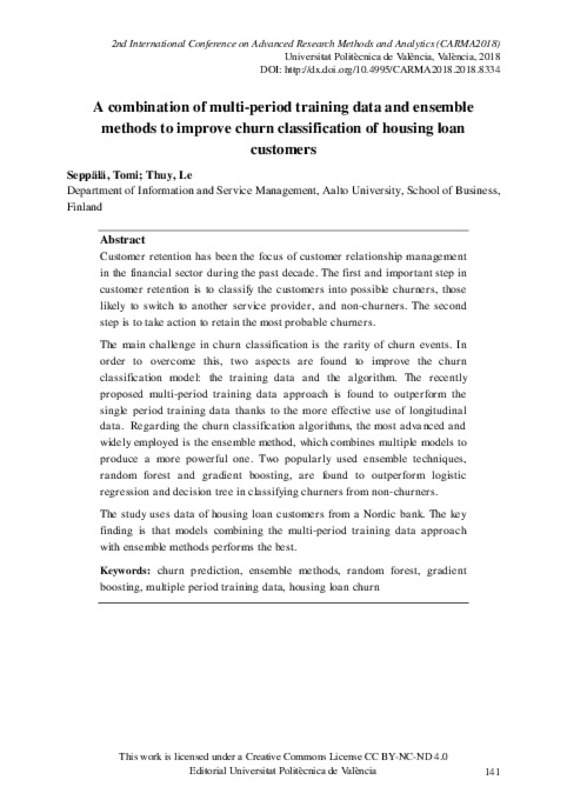JavaScript is disabled for your browser. Some features of this site may not work without it.
Buscar en RiuNet
Listar
Mi cuenta
Estadísticas
Ayuda RiuNet
Admin. UPV
A combination of multi-period training data and ensemble methods to improve churn classification of housing loan customers
Mostrar el registro sencillo del ítem
Ficheros en el ítem
| dc.contributor.author | Seppälä, Tomi
|
es_ES |
| dc.contributor.author | Thuy, Le
|
es_ES |
| dc.date.accessioned | 2018-11-07T08:31:05Z | |
| dc.date.available | 2018-11-07T08:31:05Z | |
| dc.date.issued | 2018-09-07 | |
| dc.identifier.isbn | 9788490486894 | |
| dc.identifier.uri | http://hdl.handle.net/10251/112049 | |
| dc.description.abstract | [EN] Customer retention has been the focus of customer relationship management in the financial sector during the past decade. The first and important step in customer retention is to classify the customers into possible churners, those likely to switch to another service provider, and non-churners. The second step is to take action to retain the most probable churners. The main challenge in churn classification is the rarity of churn events. In order to overcome this, two aspects are found to improve the churn classification model: the training data and the algorithm. The recently proposed multi-period training data approach is found to outperform the single period training data thanks to the more effective use of longitudinal data. Regarding the churn classification algorithms, the most advanced and widely employed is the ensemble method, which combines multiple models to produce a more powerful one. Two popularly used ensemble techniques, random forest and gradient boosting, are found to outperform logistic regression and decision tree in classifying churners from non-churners. The study uses data of housing loan customers from a Nordic bank. The key finding is that models combining the multi-period training data approach with ensemble methods performs the best. | es_ES |
| dc.format.extent | 4 | es_ES |
| dc.language | Inglés | es_ES |
| dc.publisher | Editorial Universitat Politècnica de València | es_ES |
| dc.relation.ispartof | 2nd International Conference on Advanced Reserach Methods and Analytics (CARMA 2018) | es_ES |
| dc.rights | Reconocimiento - No comercial - Sin obra derivada (by-nc-nd) | es_ES |
| dc.subject | Web data | es_ES |
| dc.subject | Internet data | es_ES |
| dc.subject | Big data | es_ES |
| dc.subject | QCA | es_ES |
| dc.subject | PLS | es_ES |
| dc.subject | SEM | es_ES |
| dc.subject | Conference | es_ES |
| dc.subject | Churn prediction | es_ES |
| dc.subject | Ensemble methods | es_ES |
| dc.subject | Random forest | es_ES |
| dc.subject | Gradient boosting | es_ES |
| dc.subject | Multiple period training data | es_ES |
| dc.subject | Housing loan churn | es_ES |
| dc.title | A combination of multi-period training data and ensemble methods to improve churn classification of housing loan customers | es_ES |
| dc.type | Capítulo de libro | es_ES |
| dc.type | Comunicación en congreso | es_ES |
| dc.identifier.doi | 10.4995/CARMA2018.2018.8334 | |
| dc.rights.accessRights | Abierto | es_ES |
| dc.description.bibliographicCitation | Seppälä, T.; Thuy, L. (2018). A combination of multi-period training data and ensemble methods to improve churn classification of housing loan customers. En 2nd International Conference on Advanced Reserach Methods and Analytics (CARMA 2018). Editorial Universitat Politècnica de València. 141-144. https://doi.org/10.4995/CARMA2018.2018.8334 | es_ES |
| dc.description.accrualMethod | OCS | es_ES |
| dc.relation.conferencename | CARMA 2018 - 2nd International Conference on Advanced Research Methods and Analytics | es_ES |
| dc.relation.conferencedate | Julio 12-13,2018 | es_ES |
| dc.relation.conferenceplace | Valencia, Spain | es_ES |
| dc.relation.publisherversion | http://ocs.editorial.upv.es/index.php/CARMA/CARMA2018/paper/view/8334 | es_ES |
| dc.description.upvformatpinicio | 141 | es_ES |
| dc.description.upvformatpfin | 144 | es_ES |
| dc.type.version | info:eu-repo/semantics/publishedVersion | es_ES |
| dc.relation.pasarela | OCS\8334 | es_ES |








